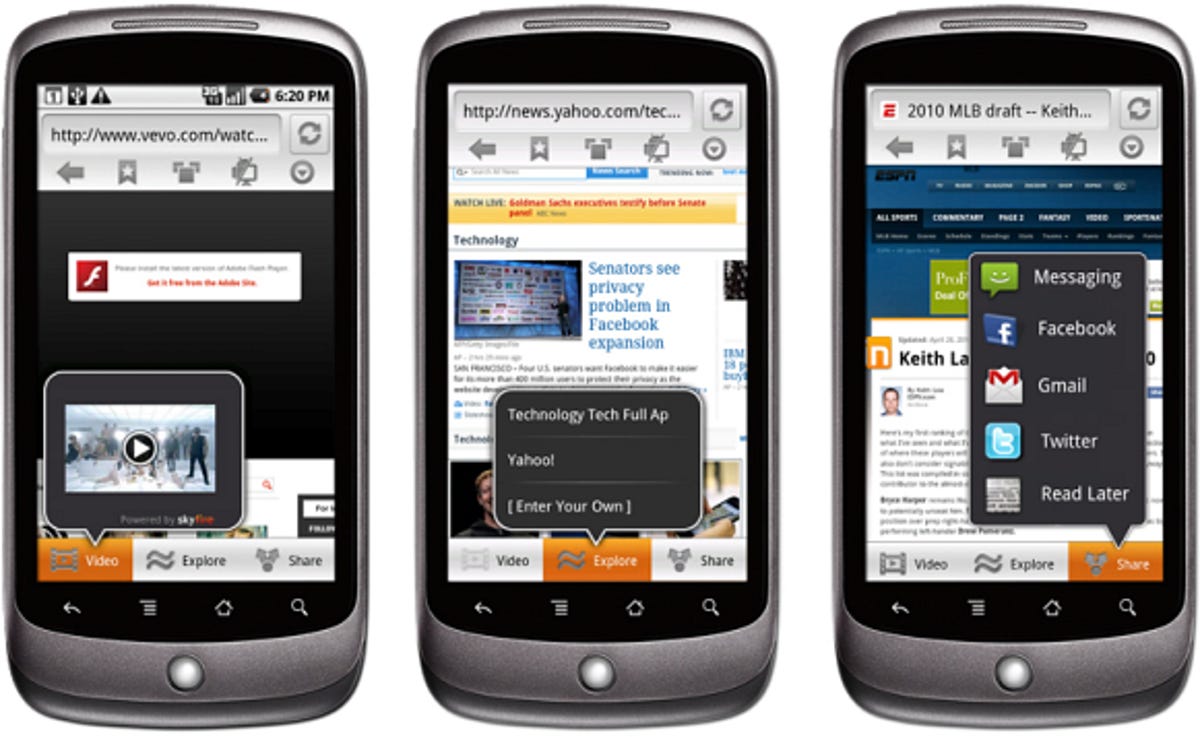Native Flash support for Android phones may be only a month away, but in the meantime, mobile browser-maker Skyfire presents a workaround in its brand-new beta app for Android phones.
Skyfire 2.0 beta for Android looks and acts like your typical souped-up WebKit browser for Android phones, with the exception of a tool that lets you stream Flash video–and soon Silverlight. WebKit doesn’t currently support either technology.
When Skyfire detects a broken embedded video on a Web page, it signals Skyfire’s servers to fetch the video and transcode it from its original format to HTML 5 video.
What’s more, Skyfire’s servers will adjust the video resolution to performance factors like your phone’s screen size and your network speed in order to provide smoother streaming. Videos certainly played without lagging or buffering interruptions in our demo with Skyfire on the Motorola Droid, and in our own tests on the Nexus One.
Skyfire’s Flash-support-by-proxy isn’t an all-in-one solution by any means. It doesn’t detect every video in a playlist. Occasionally, it crashed a browser tab. And it doesn’t address Flash games or other interactive sites; we’re still waiting for a seamless way to read Flash-based menus online.
In addition to video streaming, Skyfire also adds its twist to the Android’s WebKit browser with a button for viewing more relevant content, like headlines, images, and Twitter updates, and a link-sharing module. There’s a browser tab-switcher, a shortcut to easily switch between desktop, Android, and iPhone mode (known as user agents,) and a drop-down menu with access to the settings, download list, text selection, and other tools. The quintessential “back” arrow and bookmarking are also present. On Android phones running OS 2.0 or higher, Skyfire also supports multitouch pinch-zooming.

Skyfire
There are some known issues and limitations with the Skyfire beta’s video support and browser in general. It won’t currently stream back Windows Media, Silverlight (that’s next), or Quicktime video, and it intentionally won’t provide video or additional content for secure sites. On some sites, swapping browser modes (the user agent) will force-close the app. The Help function was turned off when we tested the app before its official launch, and there are some interface issues with the Explore window on the Motorola Backflip while in “backflip” mode.
Although Skyfire’s browser for Android is officially labeled 2.0 (beta), it is, in fact, the company’s first offering for Google’s mobile platform. The browser’s front and backend designs are what diverge it from earlier 1.0 and 1.5 models for Windows Mobile and Symbian phones, which were coded entirely by Skyfire and built to look like a traditional desktop browser. With Android, the company layered additional features onto WebKit, much like Dolphin Browser, xScope, and others.
Skyfire CEO Jeff Glueck confirmed in an interview with CNET that we should expect to see a version of Skyfire for BlackBerry soon after OS 6.0 emerges with a new WebKit-based BlackBerry browser. We’re also keeping our eyes trained on the iPhone–after Opera’s success getting its proxy browser into the App Store, Skyfire made it no secret that it intends to follow suit, this time bringing unprecedented Flash video transcoding and streaming to an OS the CEO of which has emphatically declared will never carry Flash.
You can try Skyfire 2.0 beta for Android free from the Android Market on your phone and at get.skyfire.com.



